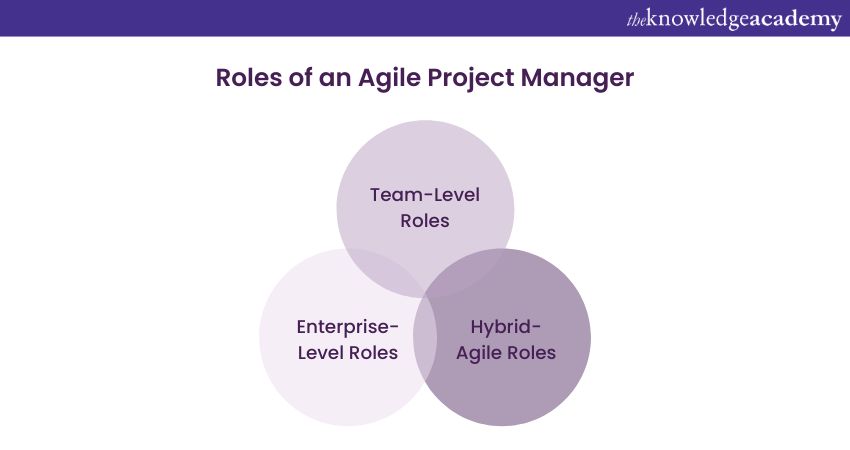We may not have the course you’re looking for. If you enquire or give us a call on 01344203999 and speak to our training experts, we may still be able to help with your training requirements.
Training Outcomes Within Your Budget!
We ensure quality, budget-alignment, and timely delivery by our expert instructors.

The Agile Project Manager assumes different roles as a leader, mentor, or coordinator. They aim to foster a productive working environment where team members are encouraged to share ideas and opinions.
According to the 16th State of Agile report by Digital, the adoption of Agile methodology in software teams increased to 86 percent in 2021. The same report revealed that 86 per cent of software development teams adopted Agile philosophies into their workplace culture. The Agile Project Manager delivers on-time, large-scale technical solutions that support critical business objectives. Discover their tasks, skills, work roles, and more.
Table of Contents
1) Understanding what is an Agile Project Manager
a) Roles
b) Responsibilities
c) Skills
2) Difference between a Traditional and an Agile Project Manager
3) Conclusion
Understanding what is an Agile Project Manager
Organisations are adopting the Agile framework of project management more than ever before. The Agile framework is essentially a collaborative methodology that utilises short bursts of development cycles referred to as ‘sprints’. These short bursts aim to incorporate feedback from stakeholders and customers throughout the project lifecycle. The main goal is to foster a mindset of flexibility and continual improvement, which results in a significantly improved product.
A team working with an Agile framework and philosophy in mind will not function well with traditional methods of workflow. This translates to a change in the job description of the Project Manager. An Agile Project Manager emphasises team collaboration rather than a hierarchical leadership structure. Kanban, Scrum, Adaptive Project Framework, and Extreme Programming are some of the popular frameworks involving Agile methodologies.
For example, the Scrum framework promotes the distribution of responsibilities that a traditional Project Manager would typically hold among the team members. Afterward, a Scrum Master is officially appointed, who serves as the team’s guide and facilitator. The traditional Project Manager’s role adapts and evolves within an Agile project environment.
The organisation must also remember that an Agile Project Manager requires the right guidance at any point. The Agile framework is flexible enough to be tailored according to the specific Agile project plan in focus. An Agile Project Manager ensures a successful and optimal product delivery.
An Agile Project Manager must possess key roles, responsibilities, and skills such as the following:
Roles

An organisation expects its Agile Project Managers to be capable of effectively managing various roles. These roles can be categorised into three categories:
Team-Level Roles
Agile Project Managers can hold two roles in the project process at the team level. They can act as consultants who delegate appropriate staff and resources to ensure the team’s efficiency and effectiveness. Additionally, Agile Project Managers can serve as coaches who advise to team members on how to optimise their efficiency while working in the team.
Enterprise-level Roles
Agile Project Managers (APM) holding enterprise-level roles need to embrace significant challenges. They can also hold the role of a director who manages multiple Agile teams. The APM can choose to integrate the team’s work with activities beyond their scope as well. Additionally, the APM can also choose to assume the roles of both a leader and a manager, taking charge of large-scale, complex projects.
Hybrid-Agile Roles
The Agile Project Manager, in this role, can combine various Agile Methods with other Non-Agile methods, such as the Waterfall method. The Waterfall method is a project development process that progresses sequentially through all project phases, similar to a waterfall flowing downward. In this method, each phase is completed before proceeding to the next one. The Agile Project Manager can also design a project management approach that is tailored to the specific project’s planning and management tasks. A hybrid Agile role can be challenging as it requires the Agile Project Manager to skilfully combine traditional work techniques with Agile methodologies.
Manage organisational changes and manage project groups with an Agile mindset. Sign up for the Agile Programme Management (AgilePgM®) course now!
Responsibilities
The APM has responsibilities that include planning, leading, organising, and encouraging their Agile project teams. The APM has a wide range of responsibilities, such as:
1) Assisting their team in achieving an optimal level of performance and work quality.
2) Ensuring team members hold each other accountable for their work and making sure less experienced team members are mentored appropriately.
3) Defining the project's schedule while balancing prompt and regular quality deliveries.
4) Organising and leading the team's project status meetings.
5) Ensuring that their team delivers business value of exemplary quality to the customers.
6) Assisting the product owner in managing communication with stakeholders and customer expectations for service deliverables to establish an effective governance system for the project.
7) Boosting their team's morale through various team-building methods and ensuring that every team member makes a meaningful contribution to the project at hand.
Agile Project Managers should practice horizontal management, which opposes the hierarchical structure of a team’s command line, and invest time in receiving both internal and external feedback from their team members. Feedback is their means of adequately responding to any changes or concerns in a timely fashion.

Skills
APMs eventually develop qualities over time during their presence in the team to ensure they fulfil their fulfilment of responsibilities as and when necessary. Let’s take a look at a list of key qualities that any APM must possess to be successful in an Agile project environment:
1) APMs must see the big picture and prioritise their work based on high-level goals.
2) APMs are expected to possess notable emotional intelligence and active listening skills, setting a standard for their team members.
3) APMs need to demonstrate exemplary communication skills across hierarchies.
4) APMs should be capable of identifying and analysing potential risks.
5) APMs can learn to resolve conflicts through adaptive leadership techniques.
6) APMs should prove their capability to continually improve work processes.
7) APMs should be well-versed in the Agile philosophy, values, and methodologies.
It is essential for an APM to envision their project goals clearly so they can effectively lead their team towards success. Demonstrating excellent communication and problem-solving skills will help them spearhead the team's progress through the project lifecycle. Moreover, attention to minor details will greatly contribute to the team’s success.
While the job description of an APM may seem intimidating and arduous at first glance, the holistic skillset of hard and soft skills drives the momentum of the team. An Agile project lifecycle is bound to face immense pressure, and it is crucial for an APM to remain calm and composed. The APM’s ability to remain composed sets an example for the team in the long term.
Possessing exemplary critical thinking skills and the ability to adapt to rapidly changing priorities are signs of a highly skilled APM.
Stay up to date with the techniques of Agile Management practices. Sign up for the Certified Professional In Agile Project Management (CPAPM) course now!
What is the difference between a Traditional Project Manager and an APM
Let's look into the differences between the two management styles in this section:
|
Traditional Project Manager |
Agile Project Manager |
|
A Traditional Project Manager utilises a conventional approach to management |
An Agile Project Manager utilises a flexible approach to management |
|
A Traditional Project Manager defines the projects' scope in an elaborate document and plans the project work tasks in extensive detail |
APM prepares an adjustable plan that allows priorities to shift throughout the project |
|
Customer involvement is before the project's commencement. |
Customer involvement stays active throughout the project. |
|
The Project Manager makes the final decision by evaluating goals and impact. |
The final decision is agreed upon after the collaboration of team members. |
|
The assigned team performs testing towards the end of the process. |
Consistent testing is conducted involving the user with the progress of the process. |
|
This management approach requires detailed planning involving extensive documentation. |
Not much documentation is required as the process is carried out in stages. |
What qualifications are needed for an APM?
To pursue an Agile Project Manager career, the educational qualification is acquiring a bachelor's degree in business management, Project Management, computer science or other related field. Sometimes, the employer may require a master's degree in business management.
It is also beneficial to consider training programs through internships, workshops, etc. These programs provide certification that reflects positively on employers. Training programs also provide exposure to industry practices, which helps to upskill and enhance employability.
Conclusion
As Agile and Scrum frameworks become significantly popular within organisations, the need for Agile Project Managers increases as well. AGMs need to play the role of exemplary project leaders rather than just project managers. The key to being a successful AGM is to fully embrace and practice the Agile mindset. The AGM can then proceed to leading by example and efficiently managing the work, rather than just managing the people.
Gain a comprehensive understanding of project management methodologies and apply PRINCE2 to your organisation. Sign up for the PRINCE2 Foundation & Practitioner Training now!
Frequently Asked Questions
Upcoming Project Management Resources Batches & Dates
Date
 Agile Project Management Foundation & Practitioner (AgilePM®)
Agile Project Management Foundation & Practitioner (AgilePM®)
Mon 13th May 2024
Mon 20th May 2024
Tue 28th May 2024
Mon 3rd Jun 2024
Mon 10th Jun 2024
Sat 15th Jun 2024, Sun 16th Jun 2024
Mon 17th Jun 2024
Mon 24th Jun 2024
Mon 1st Jul 2024
Mon 8th Jul 2024
Sat 13th Jul 2024, Sun 14th Jul 2024
Mon 15th Jul 2024
Mon 22nd Jul 2024
Mon 29th Jul 2024
Sat 3rd Aug 2024, Sun 4th Aug 2024
Mon 5th Aug 2024
Mon 12th Aug 2024
Mon 19th Aug 2024
Tue 27th Aug 2024
Mon 2nd Sep 2024
Sat 7th Sep 2024, Sun 8th Sep 2024
Mon 9th Sep 2024
Mon 16th Sep 2024
Mon 23rd Sep 2024
Mon 30th Sep 2024
Sat 5th Oct 2024, Sun 6th Oct 2024
Mon 7th Oct 2024
Mon 14th Oct 2024
Mon 21st Oct 2024
Mon 28th Oct 2024
Sat 2nd Nov 2024, Sun 3rd Nov 2024
Mon 4th Nov 2024
Mon 11th Nov 2024
Mon 18th Nov 2024
Mon 25th Nov 2024
Mon 2nd Dec 2024
Mon 9th Dec 2024
Sat 14th Dec 2024, Sun 15th Dec 2024
Mon 16th Dec 2024







 Top Rated Course
Top Rated Course



 If you wish to make any changes to your course, please
If you wish to make any changes to your course, please


